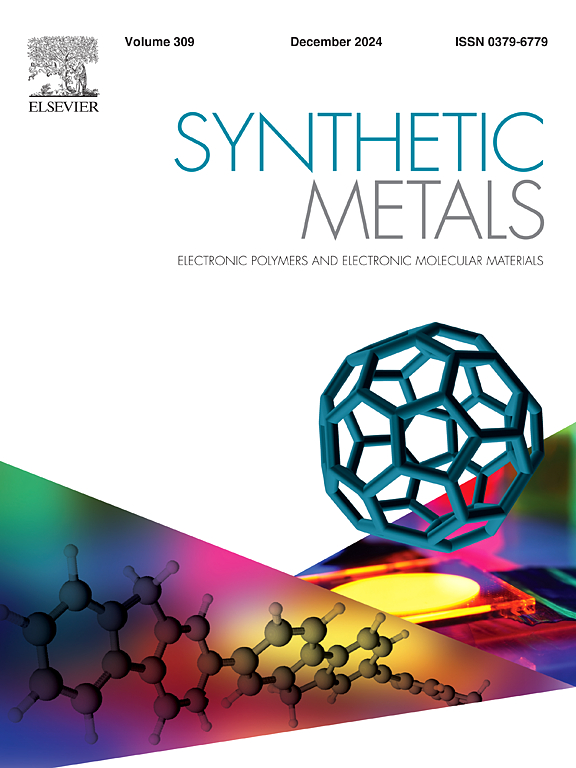Efficient visible-light-driven H2O2 production activity of covalently modified zinc phthalocyanine/g-C3N4 heterostructure
IF 4.6
3区 材料科学
Q2 MATERIALS SCIENCE, MULTIDISCIPLINARY
引用次数: 0
Abstract
Developing efficient heterojunction photocatalysts holds a great promise for advancing solar-to-chemical energy conversion. In this study, tetra-4-carboxyethylenephenoxy-substituted Zinc (II) phthalocyanine (ZnTcPc) was covalently linked to the amine-functionalized graphitic carbon nitride (g-C3N4) to create an efficient photocatalyst. The optimized ZnTcPc/g-C3N4 composite demonstrated improved photocatalytic activity relative to that of pure g-C3N4 and ZnTcPc in the generation of H2O2 under 150 W metal halide lamp at ambient temperature. The covalent integration of ZnTcPc into the g-C3N4 framework tailored its electronic structure efficiently and highlighted the potential of the ZnTcPc/g-C3N4 composite as a visible-light responsive photocatalyst. FT-IR spectroscopy revealed the establishment of novel chemical linkages between ZnTcPc and g-C3N4, indicating strong covalent interactions. SEM and TEM analyses provided insight into the morphological transformation, showing a more uniform surface texture and enhanced interface contact between the two materials, facilitating better charge transfer. XRD patterns indicated alterations to the crystalline structure, confirming the successful incorporation of ZnTcPc into the g-C3N4 lattice. Additionally, XPS analysis verified the electronic coupling between g-C3N4 and ZnTcPc, with shifts in binding energies suggesting strong electronic interaction. These findings underscore the nanocomposite's improved photocatalytic activity and responsiveness to visible light. It achieved the highest H2O2 production rate of 27.17 mg/L within 90 min, surpassing the rates of pure g-C3N4 and ZnTcPc. This synergistic photocatalytic process provides valuable insights into advancing energy conversion technologies.
共价修饰的酞菁锌/g-C3N4异质结构的高效可见光产H2O2活性
开发高效的异质结光催化剂对推进太阳能-化学能转换具有重要意义。在这项研究中,四-4-羧基乙基苯氧基取代的锌(II)酞菁(ZnTcPc)与胺功能化石墨氮化碳(g-C3N4)共价连接,以创造一种高效的光催化剂。优化后的ZnTcPc/g-C3N4复合材料在150 W金属卤化物灯下产生H2O2的光催化活性优于纯g-C3N4和ZnTcPc。ZnTcPc共价整合到g-C3N4框架中,有效地调整了其电子结构,突出了ZnTcPc/g-C3N4复合材料作为可见光响应光催化剂的潜力。FT-IR光谱显示,ZnTcPc与g-C3N4之间建立了新的化学键,显示出强的共价相互作用。SEM和TEM分析揭示了两种材料的形貌变化,表面纹理更加均匀,两种材料之间的界面接触增强,有利于更好的电荷转移。XRD图显示了晶体结构的改变,证实了ZnTcPc成功地掺入到g-C3N4晶格中。此外,XPS分析证实了g-C3N4和ZnTcPc之间的电子耦合,结合能的变化表明电子相互作用很强。这些发现强调了纳米复合材料改善的光催化活性和对可见光的响应性。在90 min内H2O2产率最高,达到27.17 mg/L,超过了纯g-C3N4和ZnTcPc的产率。这种协同光催化过程为推进能量转换技术提供了有价值的见解。
本文章由计算机程序翻译,如有差异,请以英文原文为准。
求助全文
约1分钟内获得全文
求助全文
来源期刊

Synthetic Metals
工程技术-材料科学:综合
CiteScore
8.30
自引率
4.50%
发文量
189
审稿时长
33 days
期刊介绍:
This journal is an international medium for the rapid publication of original research papers, short communications and subject reviews dealing with research on and applications of electronic polymers and electronic molecular materials including novel carbon architectures. These functional materials have the properties of metals, semiconductors or magnets and are distinguishable from elemental and alloy/binary metals, semiconductors and magnets.
 求助内容:
求助内容: 应助结果提醒方式:
应助结果提醒方式:


